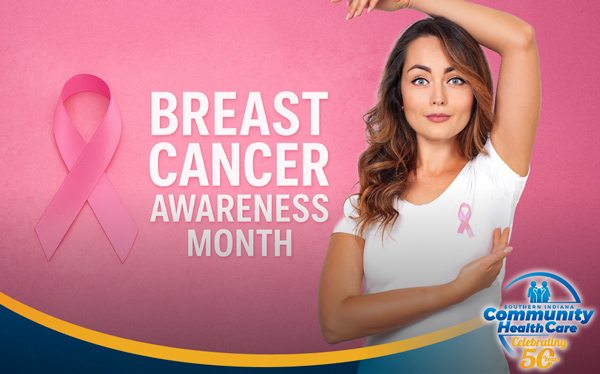Get in the Pink – Why Breast Cancer Awareness Matters

Get in the Pink – Why Breast Cancer Awareness Matters
By Curtis Thill, M.D.
Every October, the colors of autumn light up southern Indiana with vibrant reds and golds. Yet mixed in with these hues, another color takes center stage: pink. From ribbons to T-shirts, “Pinktober” is more than a seasonal campaign—it’s a reminder that breast cancer awareness saves lives.
As a physician, I know that the very word cancer can trigger fear or even denial. But avoiding the subject does not make it go away. One in eight women will face breast cancer in their lifetime, yet the outlook is far brighter than many realize. When found early, most cases are very treatable. That is the heart of Breast Cancer Awareness Month: awareness leads to action, and action can lead to better outcomes.
Vigilance Matters
The most common warning sign? An unusual lump or mass. Women who know the normal look and feel of their breasts can often detect changes early. Monthly self-checks are valuable, but they are not a substitute for regular medical screenings. Roughly 80% of breast lumps are benign, but if something feels unusual, call your healthcare provider.
While self-exams are a good practice, professional screenings are essential. Mammograms and clinical breast exams can detect cancers long before symptoms appear. Women over 40 should strongly consider annual mammograms, though earlier screening may be appropriate if risk factors exist. The difference is clear: cancers caught early are far more treatable, while advanced cases bring greater risks and complications.
If you’ve delayed your annual checkup, October is the season to act. Why carry the weight of worry when reassurance—or early treatment—can make all the difference?
Removing Barriers
Cost can be a concern, but it should never keep women from screening. Free or low-cost mammogram programs are regularly available. At Southern Indiana Community Health Care (SICHC), for example, free mobile mammogram screenings will be offered in English on December 22. Every woman deserves access to preventive care, regardless of income.
Building Everyday Prevention
Awareness is not just about screenings; it’s also about lifestyle. Daily choices can reduce breast cancer risk while boosting overall health.
- Nutrition: Cruciferous vegetables such as broccoli, cauliflower, and cabbage contain compounds that may help protect against cancer. Fresh berries supply antioxidants that shield cells. Local farm stands and co-ops make it easier to find seasonal produce (for example, check out the Farm Stand program from Lost River Co-Op & Café).
- Energy: Persistent fatigue can stem from nutritional gaps like low iron. A balanced diet restores stamina and supports immunity.
- Rest and movement: Chronic sleep loss weakens health. Light exercise improves sleep quality, helps with stress, and strengthens the body.
These steps don’t guarantee prevention, but they can significantly strengthen your body’s defenses.
A call to hope
Pink is more than a color; it’s a call to action. This October, take time for your health. Schedule your screenings, eat fresh, move daily, and rest well. Just as importantly, encourage the women around you—sisters, mothers, daughters, friends—to do the same.
Breast cancer awareness is about hope. Early detection often means full recovery, while prevention and self-care improve quality of life every day. By “getting in the pink,” you’re not only protecting your own health but also helping to spread awareness that can save others.
Dr. Curtis Thill is a board-certified family physician who has cared for the Crawford County region for more than 30 years.
